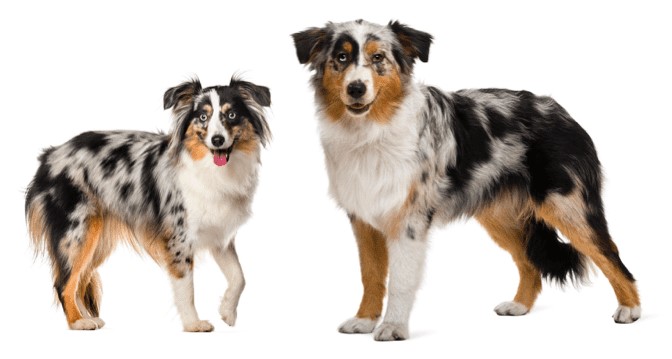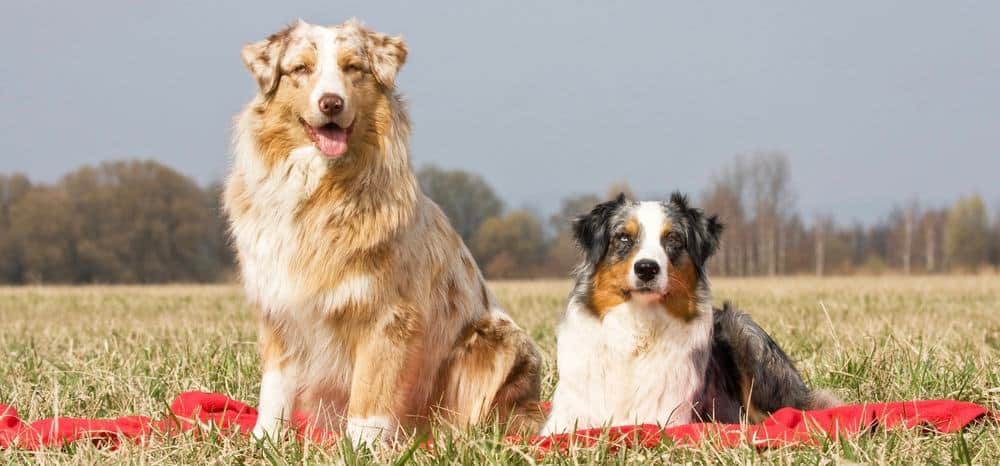
A full grown mini Australian Shepherd typically reaches 17 to 18 inches tall and weighs between 25 to 45 pounds when fully matured between 12 to 24 months old. Miniature Australian Shepherds, nicknamed “mini aussies”, are a small to medium-sized herding dog that exhibits intelligence, athleticism, and loyalty to family in a highly portable package. Though mini in size compared to their standard Australian Shepherd kin, mini aussies are huge in personality and dynamic energy.
Prospective owners are often curious what exactly to expect when bringing home one of these charismatic mini herders. How big will that adorable fluffy puppy get to be as an adult dog? What is their temperament and activity level like when full grown? This article will explore what the average full grown mini Australian Shepherd looks and acts like in terms of size, appearance, behavior, exercise requirements, and health. Read on to learn if this diminutive working breed would be the right pet for your home.
Size of Full Grown Mini Australian Shepherd
Miniature Australian Shepherds see the majority of their size development completed within their first year, reaching their full adult stature around 12-14 months of age. By the second birthday, a mini aussie hits its peak size and weight figures.
An average male mini Aussie stands 16 to 18 inches tall at the shoulder when fully grown. Females tend to run slightly smaller in the 15 to 17 inch height range. In terms of weight, a typical fully developed mini weighs between 25 to 45 pounds depending on gender, bloodline size, muscle tone, and other intrinsic factors. Generally, breeders aim to produce miniature Aussies registering no more than 18 inches tall in an effort to meet breed standards.
To illustrate the rapid early development of mini Aussies in their first year, here is a growth timeline:
- 8 weeks – 7-10 pounds
- 4 months – 15-25 pounds
- 6 months – 60-75% of adult height reached
- 9 months – Almost full adult weight
- 12-14 months – Fully developed at mature size
Factors Affecting Size Range
While mini Aussies typically fall within that 25 to 45 pound weight scale, their final size can be impacted by several variables including:
- Gender: Males tend to be taller and heavier than females
- Genetics: Some bloodlines breed smaller or larger than the breed standard
- Nutrition: A puppy fed a high-quality diet may grow slightly bigger
- Environment: Mini Aussies raised in ideal conditions may reach the top of growth ranges
Regardless of the slight differences attributable to these developmental factors, a full grown mini Australian Shepherd should not exceed 18 inches tall or be under 15 inches at maturity if responsibly bred. To illustrate their rapid early development in the first year, here is a growth timeline:
Visual Size Comparison
To demonstrate the scale difference between a standard Australian Shepherd and miniature version, here is a side by side image depicting their relative size based on averages:

This offers prospective mini owners a realistic perspective on just how petite these little herders remain even once fully matured compared to their bigger equivalents, while still bringing dynamic presence through their facial features and body language. Though mini in scale, they deliver outsized personality in classic Aussie fashion.
Appearance of Adult Mini Aussies
One of the most appealing characteristics of the mini Australian Shepherd is its striking good looks reminiscent of its standard Aussie parent breed with some unique miniature flourishes. These petite herders boast lush, eye-catching coats in trademark markings and colors. Full grown miniatures also carry the inherent athleticism common in Australian Shepherds with their agile frames built for action and adventure.
Common Coat Colors and Markings
While exhibiting significant diversity in patterns, some of the most prevalent coat colors and mixes seen in mature mini Aussies include:
- Black – Solid or with white and/or copper points
- Red Merle – Marbling of red, white and black
- Blue Merle – Marbling of gray, white and black
- Red Tri-color – White, black and reddish brown mix
In terms of markings, mini Australian Shepherds frequently showcase:
- Rust red tones throughout the coat
- Distinctive white markings on the face, chest, legs and underside
- Blackened tips on the fur and ears (“points”)
Eye Color Variations of the Full Grown Mini Australian Shepherd
Vibrant eye shades ranging from rich amber to bright blue present commonly in mature mini Aussies depending on coat color inherited:
- Blue merles typically possess striking blue eyes.
- Red merles usually carry amber, brown, hazel or greenish eyes.
- Bi-colored minis may have one blue and one brown eye.
Tails
The mini Aussie tail most often takes one of three forms:
1. Naturally bobbed tail: Short and stubby tail, 2-4 inches long
2. Docked tail: Surgically shortened tail
3. Full long tail: Reaching down to the hocks like traditional Aussies
Temperament and Behavior of the Full Grown Mini Australian Shepherd
Mini Aussies earn their popularity in part thanks to their big personalities packed into a small body. These lively dogs display intelligence, loyalty, athletic agility, and plenty of energy even as mature adults. Their temperaments also carry strong working drive and herding instincts inherited from extensive Aussie breeding programs.
As descendants of Australia’s iconic ranch dogs used to wrangle livestock, the mini Aussie inherits the shepherding tendencies tied to collecting, circling, and containing movements. This translates into the breed’s signature nipping, nudging and circling around children, pets and even objects in motion if not properly trained. Socialization from puppyhood minimizes over-eager herding behavior into maturity.
Intelligent and Responsive
Owing to their working dog lineage where instinct and trainability prove essential, mini Australian Shepherds rank among the smartest and most receptive dog breeds. Full grown minis particularly excel at canine sports like agility, flyball, competitive obedience courses, and trick training activities catering to their need for mental and physical stimulation.
Energetic and Fun-Loving
Prospective owners should prepare for an energetic adventurer in a mini Aussie of any age. When full grown, miniatures do well with plenty of aerobic exercise and outdoor adventures including long walks, hiking, playing fetch and even jobs like frisbee catching to expend their enthusiasm. A bored mini left without sufficient activity outlets may resort to nuisance barking or destructive chewing. But with proper exercise and training, they develop into a fun-loving and affectionate adult dog eager to be by your side.
Herding Drive
As descendants of Australia’s iconic herding canine used to wrangle sheep and livestock, the mini Aussie inherits strong working instincts tied to collecting, circling, and containing movements. This translates into the breed’s signature nipping, nudging and circling tendencies around children, pets and even objects in motion. Proper socialization minimizes over-exuberant herding behavior.
Care for Full Grown Miniature Aussies
While pint-sized, mini Australian Shepherds require plenty of care and dedication despite their small packages as adult dogs. Their energy and intelligence demands consistent exercise and mental stimulation. Miniatures also benefit from proper grooming and nutrition to keep their athletic frames in peak condition for their action-packed lifestyles.
Activity Requirements of the Full Grown Mini Australian Shepherd
A full grown mini Australian Shepherd that does not receive adequate activity everyday manifests anxiety, boredom, or unwanted behaviors like excessive vocalizing demands for attention. Most miniatures feel fulfilled through at least 60 minutes per day of vigorous exercise like running, hiking, backyard play sessions, alongside training activities and mentally stimulating toys. This breed thrives when it has a job or task to funnel its enthusiasm towards.
Ideal Home Settings
While highly adaptable, the ideal home for a mature mini provides enough indoor and outdoor space to sprint around and play. Safely fenced backyards offer the ability to zoom after toys and herd them back. Condos and apartments can certainly work as well for the right owner who can meet a mini Aussie’s activity needs mostly through daily walks, park visits, engaging toys and perhaps agility classes etc. Their loud barking tends not to suit all multi-dwelling housing set ups however.
Exercise Needs
Mental stimulation proves just as important as physical exercise for an adult mini Aussie. Activities like scent work, agility training courses, and advanced obedience keep their bright minds challenged. Games of catch and fetch also burn energy. Getting out for daily walks assists bonding and leadership development. A tired dog means a well-behaved mini!
Grooming and Shedding
The mini Aussie sheds moderately year-round and seasonally “blows” its thick double-coat requiring extra brushing during shedding periods. Occasional brushing removes dead hairs and keeps their coat tidy plus helps manage hair turnover flare ups. Limit full baths to necessary occasions only however as over washing strips healthy natural oils from their skin and fur.
Feeding Recommendations
As athletic herding dogs, mini Aussies do best maintaining lean muscle mass rather than unnecessary weight gain that overly stresses their joints. Tailor feeding amounts to your individual mini’s age, size and energy expenditure needs. Typical guidelines recommend:
- Puppies up to 4 months – 3-4 small meals daily
- 4 months to 1 year – 2-3 meals per day
- Full grown adults – 1-2 meals daily
When estimating exact quantities, standard mini Aussies consuming 25 calories per pound of projected adult body weight serves as a good baseline.
Health and Lifespan of the Full Grown Mini Australian Shepherd
Responsibly bred mini Australian Shepherds enjoy good health into maturity and an average life expectancy between 12 to 15 years of age. Still, the mini can be prone to certain joint, eye, neurological and genetic health conditions worth screening for before bringing one home.
Typical Lifespan
With attentive care, exercise, and preventative veterinary visits, a mini Aussie often lives a robust 12 to 15 years. Some lines demonstrate even greater longevity thanks to dedicated health testing breeding practices geared towards improvement.
Potential Health Issues of the Full Grown Mini Australian Shepherd
While miniatures share strengths with their Aussie forebears, they may also inherit similar predispositions for conditions like:
- Joint Dysplasia – Improper hip/elbow development
- Eye issues – Cataracts, progressive retinal atrophy, lens luxation, Collie Eye Anomaly
- MDR1 Drug Sensitivity – Adverse reactions to common medications
- Epilepsy – Seizure disorder possibly inherited
Therefore, it’s vital prospective owners do their research to select a miniature bred from health tested lines with all OFA and genetic screening results indicating low risk for these prevalent issues plaguing the breed. Starting with structurally and genetically sound lineage supports a long, healthy life for any mini Aussie to thrive from puppyhood into maturity as much as possible.
Conclusion: Full Grown Mini Australian Shepherd
What to expect with a full grown mini Australian Shepherd? At maturity, miniatures retain moderate scales maxing out around 18 inches tall and 45 pounds compared to standard sized Aussies, yet these little dynamos still pack outsized personalities into their petite frames. As full grown dogs, minis exhibit classic Aussie intelligence, trainability and lively energy, conveniently sized for apartments yet still needing good daily exercise.
From aesthetically pleasing coats in merle & tri colorings to their athleticism and loyal temperaments, mini Aussies represent wonderful miniature versions of the iconic ranch dogs. Yet their activity needs, tendency to be vocal, inherent herding instincts and overall maintenance present essential considerations for prospective owners lacking proper time, training ability or space. Those able to positively meet miniature Aussies’ needs will find their diminutive package brings inherent fulfillment and fun from puppy to adult and beyond!
Recent Posts
Australian Shepherd Lifespan Australian Shepherd Lifespan is 12-15 years. Learn tips on nutrition, exercise, and health care to maximize your Aussie's longevity. With their signature merle...
Introduction to the Australian Shepherd Temperament The Australian Shepherd Temperament is loyal and energetic. Learn what to expect from this intelligent herding breed's protective instincts and...
